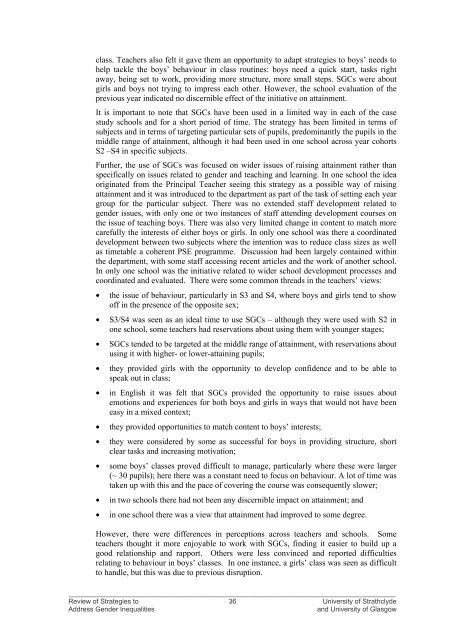Review of Strategies to Address Gender Inequalities in Scottish ...
Review of Strategies to Address Gender Inequalities in Scottish ...
Review of Strategies to Address Gender Inequalities in Scottish ...
Create successful ePaper yourself
Turn your PDF publications into a flip-book with our unique Google optimized e-Paper software.
class. Teachers also felt it gave them an opportunity <strong>to</strong> adapt strategies <strong>to</strong> boys’ needs <strong>to</strong>help tackle the boys’ behaviour <strong>in</strong> class rout<strong>in</strong>es: boys need a quick start, tasks rightaway, be<strong>in</strong>g set <strong>to</strong> work, provid<strong>in</strong>g more structure, more small steps. SGCs were aboutgirls and boys not try<strong>in</strong>g <strong>to</strong> impress each other. However, the school evaluation <strong>of</strong> theprevious year <strong>in</strong>dicated no discernible effect <strong>of</strong> the <strong>in</strong>itiative on atta<strong>in</strong>ment.It is important <strong>to</strong> note that SGCs have been used <strong>in</strong> a limited way <strong>in</strong> each <strong>of</strong> the casestudy schools and for a short period <strong>of</strong> time. The strategy has been limited <strong>in</strong> terms <strong>of</strong>subjects and <strong>in</strong> terms <strong>of</strong> target<strong>in</strong>g particular sets <strong>of</strong> pupils, predom<strong>in</strong>antly the pupils <strong>in</strong> themiddle range <strong>of</strong> atta<strong>in</strong>ment, although it had been used <strong>in</strong> one school across year cohortsS2 –S4 <strong>in</strong> specific subjects.Further, the use <strong>of</strong> SGCs was focused on wider issues <strong>of</strong> rais<strong>in</strong>g atta<strong>in</strong>ment rather thanspecifically on issues related <strong>to</strong> gender and teach<strong>in</strong>g and learn<strong>in</strong>g. In one school the ideaorig<strong>in</strong>ated from the Pr<strong>in</strong>cipal Teacher see<strong>in</strong>g this strategy as a possible way <strong>of</strong> rais<strong>in</strong>gatta<strong>in</strong>ment and it was <strong>in</strong>troduced <strong>to</strong> the department as part <strong>of</strong> the task <strong>of</strong> sett<strong>in</strong>g each yeargroup for the particular subject. There was no extended staff development related <strong>to</strong>gender issues, with only one or two <strong>in</strong>stances <strong>of</strong> staff attend<strong>in</strong>g development courses onthe issue <strong>of</strong> teach<strong>in</strong>g boys. There was also very limited change <strong>in</strong> content <strong>to</strong> match morecarefully the <strong>in</strong>terests <strong>of</strong> either boys or girls. In only one school was there a coord<strong>in</strong>ateddevelopment between two subjects where the <strong>in</strong>tention was <strong>to</strong> reduce class sizes as wellas timetable a coherent PSE programme. Discussion had been largely conta<strong>in</strong>ed with<strong>in</strong>the department, with some staff access<strong>in</strong>g recent articles and the work <strong>of</strong> another school.In only one school was the <strong>in</strong>itiative related <strong>to</strong> wider school development processes andcoord<strong>in</strong>ated and evaluated. There were some common threads <strong>in</strong> the teachers’ views:• the issue <strong>of</strong> behaviour, particularly <strong>in</strong> S3 and S4, where boys and girls tend <strong>to</strong> show<strong>of</strong>f <strong>in</strong> the presence <strong>of</strong> the opposite sex;• S3/S4 was seen as an ideal time <strong>to</strong> use SGCs – although they were used with S2 <strong>in</strong>one school, some teachers had reservations about us<strong>in</strong>g them with younger stages;• SGCs tended <strong>to</strong> be targeted at the middle range <strong>of</strong> atta<strong>in</strong>ment, with reservations aboutus<strong>in</strong>g it with higher- or lower-atta<strong>in</strong><strong>in</strong>g pupils;• they provided girls with the opportunity <strong>to</strong> develop confidence and <strong>to</strong> be able <strong>to</strong>speak out <strong>in</strong> class;• <strong>in</strong> English it was felt that SGCs provided the opportunity <strong>to</strong> raise issues aboutemotions and experiences for both boys and girls <strong>in</strong> ways that would not have beeneasy <strong>in</strong> a mixed context;• they provided opportunities <strong>to</strong> match content <strong>to</strong> boys’ <strong>in</strong>terests;• they were considered by some as successful for boys <strong>in</strong> provid<strong>in</strong>g structure, shortclear tasks and <strong>in</strong>creas<strong>in</strong>g motivation;• some boys’ classes proved difficult <strong>to</strong> manage, particularly where these were larger(~ 30 pupils); here there was a constant need <strong>to</strong> focus on behaviour. A lot <strong>of</strong> time wastaken up with this and the pace <strong>of</strong> cover<strong>in</strong>g the course was consequently slower;• <strong>in</strong> two schools there had not been any discernible impact on atta<strong>in</strong>ment; and• <strong>in</strong> one school there was a view that atta<strong>in</strong>ment had improved <strong>to</strong> some degree.However, there were differences <strong>in</strong> perceptions across teachers and schools. Someteachers thought it more enjoyable <strong>to</strong> work with SGCs, f<strong>in</strong>d<strong>in</strong>g it easier <strong>to</strong> build up agood relationship and rapport. Others were less conv<strong>in</strong>ced and reported difficultiesrelat<strong>in</strong>g <strong>to</strong> behaviour <strong>in</strong> boys’ classes. In one <strong>in</strong>stance, a girls’ class was seen as difficult<strong>to</strong> handle, but this was due <strong>to</strong> previous disruption.______________________________________________________________________________________<strong>Review</strong> <strong>of</strong> <strong>Strategies</strong> <strong>to</strong> 36 University <strong>of</strong> Strathclyde<strong>Address</strong> <strong>Gender</strong> <strong>Inequalities</strong>and University <strong>of</strong> Glasgow
















